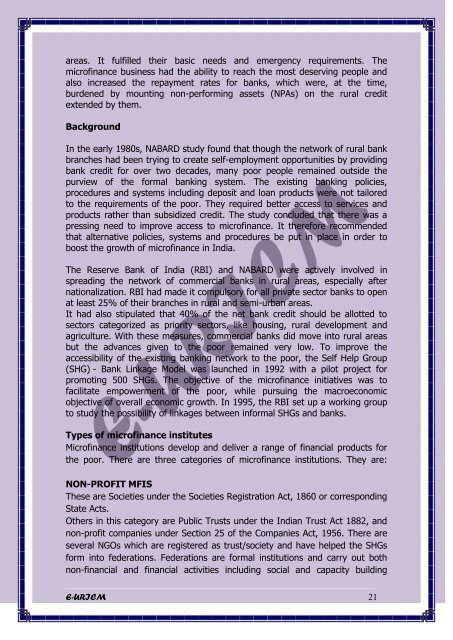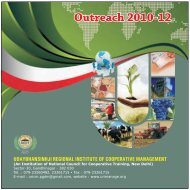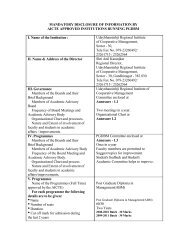URICM - UDAYBHANSINHJI - Regional Institute of Cooperative ...
URICM - UDAYBHANSINHJI - Regional Institute of Cooperative ...
URICM - UDAYBHANSINHJI - Regional Institute of Cooperative ...
You also want an ePaper? Increase the reach of your titles
YUMPU automatically turns print PDFs into web optimized ePapers that Google loves.
areas. It fulfilled their basic needs and emergency requirements. Themicr<strong>of</strong>inance business had the ability to reach the most deserving people andalso increased the repayment rates for banks, which were, at the time,burdened by mounting non-performing assets (NPAs) on the rural creditextended by them.BackgroundIn the early 1980s, NABARD study found that though the network <strong>of</strong> rural bankbranches had been trying to create self-employment opportunities by providingbank credit for over two decades, many poor people remained outside thepurview <strong>of</strong> the formal banking system. The existing banking policies,procedures and systems including deposit and loan products were not tailoredto the requirements <strong>of</strong> the poor. They required better access to services andproducts rather than subsidized credit. The study concluded that there was apressing need to improve access to micr<strong>of</strong>inance. It therefore recommendedthat alternative policies, systems and procedures be put in place in order toboost the growth <strong>of</strong> micr<strong>of</strong>inance in India.The Reserve Bank <strong>of</strong> India (RBI) and NABARD were actively involved inspreading the network <strong>of</strong> commercial banks in rural areas, especially afternationalization. RBI had made it compulsory for all private sector banks to openat least 25% <strong>of</strong> their branches in rural and semi-urban areas.It had also stipulated that 40% <strong>of</strong> the net bank credit should be allotted tosectors categorized as priority sectors, like housing, rural development andagriculture. With these measures, commercial banks did move into rural areasbut the advances given to the poor remained very low. To improve theaccessibility <strong>of</strong> the existing banking network to the poor, the Self Help Group(SHG) - Bank Linkage Model was launched in 1992 with a pilot project forpromoting 500 SHGs. The objective <strong>of</strong> the micr<strong>of</strong>inance initiatives was t<strong>of</strong>acilitate empowerment <strong>of</strong> the poor, while pursuing the macroeconomicobjective <strong>of</strong> overall economic growth. In 1995, the RBI set up a working groupto study the possibility <strong>of</strong> linkages between informal SHGs and banks.Types <strong>of</strong> micr<strong>of</strong>inance institutesMicr<strong>of</strong>inance institutions develop and deliver a range <strong>of</strong> financial products forthe poor. There are three categories <strong>of</strong> micr<strong>of</strong>inance institutions. They are:NON-PROFIT MFISThese are Societies under the Societies Registration Act, 1860 or correspondingState Acts.Others in this category are Public Trusts under the Indian Trust Act 1882, andnon-pr<strong>of</strong>it companies under Section 25 <strong>of</strong> the Companies Act, 1956. There areseveral NGOs which are registered as trust/society and have helped the SHGsform into federations. Federations are formal institutions and carry out bothnon-financial and financial activities including social and capacity buildingE-<strong>URICM</strong> 21





